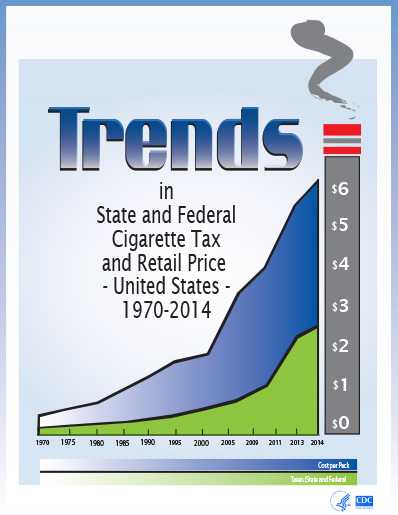Economic Trends in Tobacco
Tobacco-Related Spending
In 2014, tobacco companies spent more than $9 billion marketing cigarettes and smokeless tobacco in the United States. This amount translates to nearly $25 million each day, or about $1 million every hour.1
- Cigarette advertising and promotional expenses totaled approximately $8.49 billion in 2014—down from $8.95 billion during 2013. In 2014, about 80% (nearly $6.8 billion) of this was spent on price discounts paid to cigarette retailers or wholesalers to reduce the cost of cigarettes to consumers.1
- Manufacturers spent a total of $600.8 million on smokeless tobacco advertising and promotion during 2014—up from $503.2 million in 2013.2
- A number of electronic products, such as electronic cigarettes (e-cigarettes), electronic cigars (e-cigars), and electronic pipes (e-pipes), are being introduced in the marketplace. However, current information on spending for marketing and promotion of these products is not available.
- Sales of e-cigarettes grew considerably during 2012–2013, including about 320% for disposable e-cigarettes, 72% for starter kits, and 82% for cartridges.3
NOTE: Advertising and promotional expenses include items such as magazine ads, distribution of cigarette samples or coupons for free samples, ads posted in retail stores, price discounts, payments to retailers for displaying brands, volume rebates for wholesalers, and direct-mail advertising.
Trends in State and Federal Cigarette Tax and Retail Price—United States, 1970–2014
Larger infographic
Tobacco Production in the United States
Although U.S. tobacco production has decreased significantly since the 1980s (from nearly 180,000 tobacco-growing farms to about 10,000 in 2012), the United States continues to be a leading producer of tobacco leaves.4,5
- The United States is the fourth largest tobacco-producing country in the world, following China, India, and Brazil.
- Farms in the United States produced nearly 800 million pounds of tobacco in 2012.
- In 2012, tobacco was grown in 19 U.S. states, with North Carolina, Kentucky, and Georgia accounting for nearly 80% of total production.

Tobacco Sales
Cigarette Sales
- During 2016, about 258 billion cigarettes were sold in the United States—a 2.5% decrease from the 264 billion sold in 2015.6
- Four companies—Philip Morris USA, Reynolds American Inc., ITG Brands, and Liggett—accounted for about 92% of U.S. cigarette sales.
- Imports, primarily from Canada and South Korea, accounted for approximately 8.5% of U.S. cigarette inventories in 2015 and 8.2% in 2016.
- By state, the average retail price of a pack of 20 cigarettes (full-priced brands), including federal and state excise taxes, ranged from $5.06 in Missouri to $10.56 in New York, as of November 2014.7
- On average, federal and state excise taxes account for 43.8% of the retail price of cigarettes.7
Other Tobacco Product Sales
- About 13 billion cigars, including 12.4 billion large cigars and cigarillos and 0.6 billion little cigars, were sold in the United States in 2014.8
- The total amount of smokeless tobacco sold by manufacturers to wholesalers and retailers in the United States was approximately 128.0 million pounds in 2013, an increase from 125.5 million pounds sold in 2012.2
- In 2011, three companies—U.S. Smokeless Tobacco Company, American Snuff, and Swedish Match—accounted for nearly 90% of U.S. sales of smokeless tobacco.9
Economic Costs Associated With Smoking
Cost of Smoking-Related Illness
- Smoking-related illness in the United States costs more than $300 billion each year, including:10,11
- Nearly $170 billion for direct medical care for adults
- More than $156 billion in lost productivity, including $5.6 billion in lost productivity due to secondhand smoke exposure
Effects of Increased Prices
Increasing the price of tobacco products is the single most effective way to reduce consumption.12
- A 10% increase in price has been estimated to reduce overall cigarette consumption by 3–5%.
- Research on cigarette consumption suggests that both youth and young adults are two to three times more likely to respond to increases in price than adults.

References
- Federal Trade Commission. Federal Trade Commission Cigarette Report for 2014[PDF–508 KB]. Washington: Federal Trade Commission, 2016 [accessed 2017 Jun 15].
- Federal Trade Commission. Federal Trade Commission Smokeless Tobacco Report for 2014[PDF–563 KB]. Washington: Federal Trade Commission, 2016 [accessed 2017 Jun 15].
- Loomis BR, Rogers T, King BA. National and State-Specific Sales and Prices for Electronic Cigarettes—U.S., 2012–2013. American Journal of Preventive Medicine 2015;doi:10.1016/j.amepre.2015.05.003 [accessed 2017 Jun 15].
- U.S. Department of Agriculture. 2012 Census of Agriculture: United States Summary and State Data, Volume 1, Part 51[PDF–34 MB]. Washington: U.S. Department of Agriculture, National Agricultural Statistics Service, 2014 [accessed 2017 Jun 15].
- Eriksen M, Mackay J, Schluger N, et al. The Tobacco Atlas, Fifth Edition[PDF–16.9 MB]. Atlanta: American Cancer Society; New York: World Lung Foundation, 2015 [accessed 2017 Jun 15].
- Maxwell JC. The Maxwell Report: Year End & Fourth Quarter 2016 Cigarette Industry. Richmond, VA: John C. Maxwell, Jr., 2017 [cited 2017 Jun 15].
- Orzechowski and Walker. The Tax Burden on Tobacco[PDF–1.45 MB]. Arlington (VA): Orzechowski and Walker, 2014 [accessed 2017 Jun 15].
- Maxwell JC. The Maxwell Report: Cigar Industry in 2014. John C. Maxwell, Jr., April 2015 [cited 2017 Jun 15].
- Maxwell JC. The Maxwell Report: The Smokeless Tobacco Industry in 2011. John C. Maxwell, Jr., 2012 [cited 2017 Jun 15].
- U.S. Department of Health and Human Services. The Health Consequences of Smoking—50 Years of Progress: A Report of the Surgeon General. Atlanta: U.S. Department of Health and Human Services, Centers for Disease Control and Prevention, National Center for Chronic Disease Prevention and Health Promotion, Office on Smoking and Health, 2014 [accessed 2017 Jun 15].
- Xu X, Bishop EE, Kennedy SM, Simpson SA, Pechacek TF. Annual Healthcare Spending Attributable to Cigarette Smoking: An Update. American Journal of Preventive Medicine 2014;48(3):326–33 [accessed 2017 Jun 15].
- U.S. Department of Health and Human Services. Preventing Tobacco Use Among Youth and Young Adults: A Report of the Surgeon General. Atlanta: U.S. Department of Health and Human Services, Centers for Disease Control and Prevention, National Center for Chronic Disease Prevention and Health Promotion, Office on Smoking and Health, 2012 [accessed 2017 Jun 15].
For Further Information
Centers for Disease Control and Prevention
National Center for Chronic Disease Prevention and Health Promotion
Office on Smoking and Health
E-mail: tobaccoinfo@cdc.gov
Phone: 1-800-CDC-INFO
Media Inquiries: Contact CDC’s Office on Smoking and Health press line at 770-488-5493.
- Page last reviewed: June 16, 2017
- Page last updated: June 16, 2017
- Content source:


 ShareCompartir
ShareCompartir
